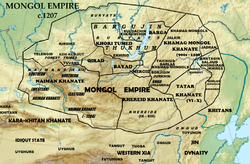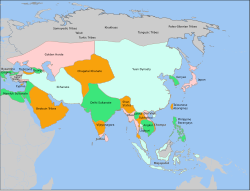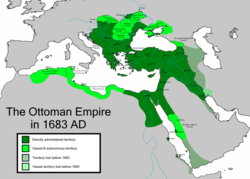World History empires name meanings study guide: Difference between revisions
| Line 324: | Line 324: | ||
|- | |- | ||
| colspan="4" | | | colspan="4" | | ||
* | * '''Caliphate''' from "Caliph" which means successor of Muhammad | ||
** literally translated from Arabic = "Successor of the Messenger of God" | ** literally translated from Arabic = "Successor of the Messenger of God" | ||
** the Caliph was considered ruler of the entire Muslim world (called the "umma" for "follower of Islam") | ** the Caliph was considered ruler of the entire Muslim world (called the "umma" for "follower of Islam") | ||
*** note that "umma" transcends ethnic/ tribal alliances | *** note that "umma" transcends ethnic/ tribal alliances | ||
** Sunni Caliphs were elected or selected by Islamic leaders | ** Sunni Caliphs were elected or selected by Islamic leaders | ||
* | * '''Islam''' means "submit to God" | ||
* | * '''Sharia''' is the Islamic law | ||
** includes civil, political and criminal codes governing crime, family, trade, education, daily life and routines | ** includes civil, political and criminal codes governing crime, family, trade, education, daily life and routines | ||
* | * '''Sunni''' = "community" | ||
** started by Muhammad's father-in-law, Abu Bakr | ** started by Muhammad's father-in-law, Abu Bakr | ||
** Sunnis follow Caliphs | ** Sunnis follow Caliphs | ||
* | ** Sunni religious rule is decentralized and localized | ||
* '''Shi'a''' or '''Shiite''' is from "Shi'aat Ali" for "followers of Ali" | |||
** Ali was Muhammad's son-in-law and the husband of his daughter, Fatima | ** Ali was Muhammad's son-in-law and the husband of his daughter, Fatima | ||
** Shiites did not recognize the first three Caliphates as legiitimate | ** Shiites did not recognize the first three Caliphates as legiitimate | ||
** Shi'a religious and political rule is centralized and extremely antagonistic towards Sunnis | |||
* '''Sayyid''' is a title of descendancy from Muhummad | |||
** Sunni rules for the title require expertise on the Koran | |||
** Shia claims for the title are more political | |||
** "Sharif" comes from "sayyid" | |||
|[[File:Map of expansion of Caliphate.svg|thumb|Map of expansion of Islamic rule: - Expansion under Muhammad, 622-632- Expansion during the Rashidun Caliphate, 632-661- Expansion during the Umayyad Caliphate, 661-750|none|250x250px]] | |[[File:Map of expansion of Caliphate.svg|thumb|Map of expansion of Islamic rule: - Expansion under Muhammad, 622-632- Expansion during the Rashidun Caliphate, 632-661- Expansion during the Umayyad Caliphate, 661-750|none|250x250px]] | ||
|- | |- | ||
| Line 354: | Line 360: | ||
* did not establish a monarchy, so succession was not hereditary | * did not establish a monarchy, so succession was not hereditary | ||
* all four Rashidun Caliphs were related to Muhammad through marriage | * all four Rashidun Caliphs were related to Muhammad through marriage | ||
[[File:IslamicConquestsIroon.png|thumb|Political alignment at eve of Muslim conquest of Middle East: - Byzantine Empire controlled Asia Minor, Greece, Levant (eastern coast of Mediterranean) and North Africa - Sasanian Empire controlled Peria and Mesopotamia | |||
- Rashidun Caliphate controls Arabia and was highly expansionist|alt=|left|250x250px]] | |||
|- | |- | ||
| | | | ||
| Line 416: | Line 425: | ||
* Persian | * Persian | ||
* also called "Safavid Dynasty" | * also called "Safavid Dynasty" | ||
* started by Shah Ismail I | |||
** hated Sunnis and forcibly converted Iran to Shi'a | |||
** he enforced "ritual cursing" of the 1st three Sunni Caliphs | |||
* took title "Shahanshah" for "king of kings" ("Shah" = king) | |||
* Safavid rulers claimed "sayyid" (or "sharif" for descendancy from Muhammad | |||
|1501-1736 | |1501-1736 | ||
|Persia | |Persia, conquered Baghdad in 1508 (in modern day Iraq) | ||
| | | | ||
* made Shi'a Islam official and forcibly converted Sunni Muslims | * made Shi'a Islam official and forcibly converted Sunni Muslims | ||
** the change put the empire at odds w/ the Sunni Ottomans | ** the change put the empire at odds w/ the Sunni Ottomans | ||
* one of the "gunpowder empires" | * one of the "gunpowder empires" | ||
* Safavid empire origins are multicultrual | |||
|} | |} | ||
Other dynasties, empires or concepts: | |||
=== Gunpower empires === | |||
[[File:Islamic Gunpowder Empires.jpg|thumb|Islamic Gunpowder Empires|alt=Islamic Gunpowder Empires.jpg|none]]--> | |||
[[Category:World History]] | [[Category:World History]] | ||
[[Category:AP World History]] | [[Category:AP World History]] | ||
[[Category:Social Studies skills]] | [[Category:Social Studies skills]] | ||
Revision as of 19:01, 5 January 2023
Goal of this article is to help students identify context and historical recollection via definitions of historical names and terms
- along with memorizing names, places (map literacy) and dates
- historical knowledge and test-day recollection can be enhanced through etymology, or word origins of key historical places, empires or dynasties
Concepts & notes[edit | edit source]
Cultural Diffusion: are conquerors eventually conquered by the conquered?[edit | edit source]
- a common thread to studies of rise and fall of empires and dynasties is cultural diffusion
- cultural diffusion = the spreading and mixing of cultures, populations, technologies, disease, etc.
- we will see in this review over and over how many conquerors become more like the people and places they conquered than what / who they were at the start of the conquest
Standardization & unity[edit | edit source]
- empires rule and spread rule through the process of standardization
- while we think of standardization as making things the same, it can also mean treating disparate groups equally
- i.e., under legal or political standards of either tolerance or favor
- in such systems, different groups may be treated unequally, but in a standardized system, the law or governance treats them consistently, if not equally
- i.e., Islamic legal distinctions between Muslims and non-Muslims
- different taxes, military service, etc.
- i.e., Islamic legal distinctions between Muslims and non-Muslims
- typical methods of standardization and unity include
- writing / language
- laws
- taxation
- currency/ money
- road & canal building
- official religion and/or religious tolerance
China empires/ dynasties[edit | edit source]
| Name | Name definition | Dates | Region | Notes |
|---|---|---|---|---|
| Chinese dynasties follow four general categories of name origins: |
|
| ||
Yuan Dynasty[edit | edit source] |
|
1271–1368 |
| |
Ming Dynasty[edit | edit source] |
|
1368-1644 |
| |
Qing Dynasty[edit | edit source] |
|
1644–1911 | Manchuria, China |
|
Mongol empires[edit | edit source]
| Name | Name definition | Dates | Region | Notes | |
|---|---|---|---|---|---|
Mongol Empire[edit | edit source] |
|
1206–1368 | Eurasia |

 | none |
Yuan Dynasty[edit | edit source] |
see above under China dynasties for Yuan | 1271–1368 | |||
Golden Horde (Mongol)[edit | edit source] |
|
| |||
Chagatai Khanate[edit | edit source] |
|
1242-1347 /
1347-1487 |
| ||
Ilkhanate Khanate[edit | edit source] |
|
1256–1335 | Persia & northern Middle East/ Anatolia |

|
Europe monarchies/ empires[edit | edit source]
India empires[edit | edit source]
| Name | Name definition | Dates | Region | Notes |
|---|---|---|---|---|
| Timurid Empire |
|
1370–1507 | Persia (Iran), central Aisa, northern India |
|
| Mughal Empire |
|
1526–1857 |
Islamic Caliphates & empires[edit | edit source]
| Name | Name definition | Dates | Region | Notes |
|---|---|---|---|---|
Notes: on Islamic Caliphates and empires[edit | edit source] |
||||
|
 | |||
Rashidun Caliphate[edit | edit source] |
|
632–661 | Middle East, North Africa, southwestern Anatolia |
 |
Umayyad Caliphate[edit | edit source] |
|
661–750 |
| |
Abbasid Caliphate[edit | edit source] |
|
750-1258 | Lower Middle East |
|
| Turks/ Seljuk Turks | ||||
Ottoman Empire[edit | edit source] |
|
1517–1924 | Middle East, Anatolia, Southeastern Europe, Greece, North Africa |
 |
Safavid Empire[edit | edit source] |
|
1501-1736 | Persia, conquered Baghdad in 1508 (in modern day Iraq) |
|
Other dynasties, empires or concepts:
Gunpower empires[edit | edit source]

-->
